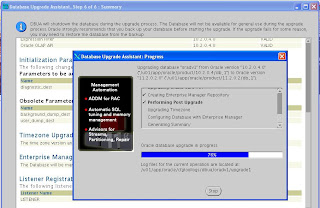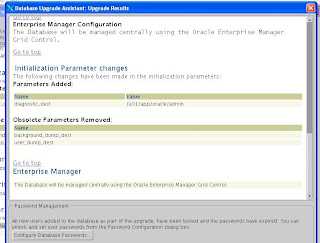Connect to the node being deleted (dbss8002) as root and execute the rootdelete.sh script to prepare it for the CRS removal.
Remove CRS from dbss8002 (Update OCR):
From any of the remaining nodes other than the one that is being deleted, execute the rootdeletenode.sh script as a root user to remove the node2-pub from the OCR.
You need node name as well as node number for the node that is being deleted. You can get this information by running olsnodes -n command line utility.
Update the Inventory for CRS on the remaining Nodes:
The inventory has alredy been updated for the DB_HOME as well as ASM_HOME. In my case, I connect to node1-pub and run below command.
Starting Oracle Universal Installer...
Checking swap space: must be greater than 500 MB. Actual 3023 MB Passed
Checking monitor: must be configured to display at least 256 colors
>>> Could not execute auto check for display colors using command /usr/X11R6/bin/xdpyinfo. Check if the DISPLAY variable is set. Failed <<<<
>>> Ignoring required pre-requisite failures. Continuing...
The inventory pointer is located at /etc/oraInst.loc
The inventory is located at /u01/app/oraInventory
'UpdateNodeList' was successful.
dbss8001:/u01/app/root/product/11.1.0/crs/bin # ./crs_stat -t
Name Type Target State Host
------------------------------------------------------------
ora....01.lsnr application ONLINE ONLINE dbss8001
ora....001.gsd application ONLINE ONLINE dbss8001
ora....001.ons application ONLINE ONLINE dbss8001
ora....001.vip application ONLINE ONLINE dbss8001
ora.oradv1.db application ONLINE ONLINE dbss8001
ora....11.inst application ONLINE ONLINE dbss8001
/u01/app/root/product/11.1.0/crs/install/rootdelete.sh local nosharedvar nosharedhomeRemove CRS from dbss8002 (Update OCR):
From any of the remaining nodes other than the one that is being deleted, execute the rootdeletenode.sh script as a root user to remove the node2-pub from the OCR.
You need node name as well as node number for the node that is being deleted. You can get this information by running olsnodes -n command line utility.
/u01/app/root/product/11.1.0/crs/install/rootdeletenode.sh <node to be deleted>,<node_numnber>
/u01/app/root/product/11.1.0/crs/install/rootdeletenode.sh dbss8002,2 Update the Inventory for CRS on the remaining Nodes:
The inventory has alredy been updated for the DB_HOME as well as ASM_HOME. In my case, I connect to node1-pub and run below command.
export ORACLE_HOME=/u01/app/root/product/11.1.0/crs echo $ORACLE_HOME cd /u01/app/root/product/11.1.0/oui/bin ./runInstaller -ignoreSysPrereqs -updateNodeList ORACLE_HOME=$ORACLE_HOME CLUSTER_NODES=dbss8001 CRS=TRUE Verify that the node is removed successfully:
Verify that the node has been removed successfully by looking at OCR through various command like olsnodes. Also, run the lsinventory to make sure that the Inventory does not know of the node that has been deleted. (in case of 2 or nore node RAC system).
Verify that the node has been removed successfully by looking at OCR through various command like olsnodes. Also, run the lsinventory to make sure that the Inventory does not know of the node that has been deleted. (in case of 2 or nore node RAC system).
Checking swap space: must be greater than 500 MB. Actual 3023 MB Passed
Checking monitor: must be configured to display at least 256 colors
>>> Could not execute auto check for display colors using command /usr/X11R6/bin/xdpyinfo. Check if the DISPLAY variable is set. Failed <<<<
>>> Ignoring required pre-requisite failures. Continuing...
The inventory pointer is located at /etc/oraInst.loc
The inventory is located at /u01/app/oraInventory
'UpdateNodeList' was successful.
dbss8001:/u01/app/root/product/11.1.0/crs/bin # ./crs_stat -t
Name Type Target State Host
------------------------------------------------------------
ora....01.lsnr application ONLINE ONLINE dbss8001
ora....001.gsd application ONLINE ONLINE dbss8001
ora....001.ons application ONLINE ONLINE dbss8001
ora....001.vip application ONLINE ONLINE dbss8001
ora.oradv1.db application ONLINE ONLINE dbss8001
ora....11.inst application ONLINE ONLINE dbss8001































































